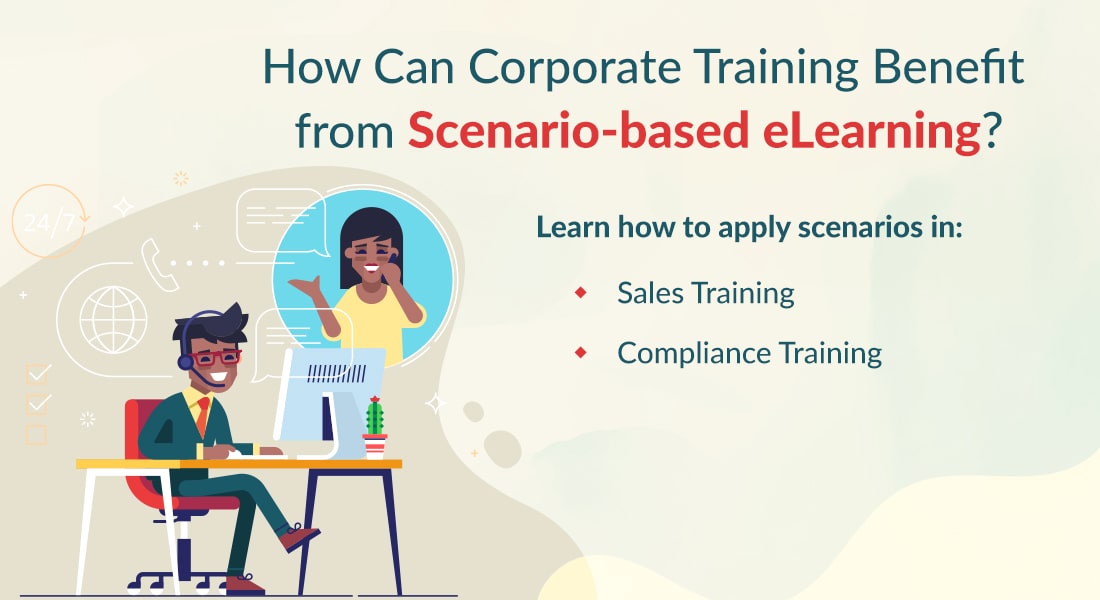How to Create Engaging Scenario-based eLearning Courses?

As children, we learned the most important lessons from experience. For example, our parents warned us that boiling water would scald, but we learned only after experimenting 😊 Now as adults navigating our way through professional life, there is still no better way of learning than from experiences. And scenario-based eLearning courses often prove to be very effective when it comes to corporate training, helping employees learn without any real-life repercussions.
Want to Design Compelling Scenario-based eLearning courses?
Follow these 7 steps:
- Identify your target audience
- Analyze their needs
- Determine outcomes based on learning needs
- Identify critical on-the-job scenarios
- Choose the right scenario structure
- Identify realistic trigger events
- Use feedback as instructional tool
What is Scenario-based eLearning
Scenario-based learning is teaching concepts through stories. The story has a plot, characters, and situations that demand the learner’s application of knowledge and skills. The story presents problems commonly faced by learners at work. Storytelling generates empathy between the employees and characters, resulting in an immersive experience.
Your employees put themselves in the character’s shoes to solve problems with active learning, creating experiences that guide them during the job. Scenario-based eLearning is an interactive program that creates a safe, virtual atmosphere to allow employees navigate commonly faced situations in a role. It nurtures problem-solving and decision-making skills and lets employees understand how their actions affect people around them, without real-life consequences.
Since scenario-based eLearning courses hook learners emotionally, it is an effective form of sticky learning. It can be utilized for ‘boring’ or ‘tricky’ information, which is easy to forget in a routine but can have lasting repercussions – such as compliance training.
Why Scenario-based eLearning?
Scenario-based eLearning courses have gained wide popularity due to their efficacy as a sticky learning method. Inculcating scenario-based eLearning in corporate training can have lasting benefits. If you are not already convinced of incorporating this tool, here are a few reasons why you should use scenario-based eLearning:
- Motivates employees to learn by doing
- Provides a safe environment to practice, makes a healthy room for challenges and leveling up difficulties
- Assesses application of knowledge and skills
- Offers immediate feedback to help make the right decisions
→ Interested in learning more about sticky learning? Download this webinar recording!
Steps to Design Scenario-based eLearning Courses
Now that you are ready to include scenario-based eLearning courses for corporate training, let us understand how to design them. You must understand that engaging storytelling lies at the crux of scenario-based learning. These stories should present relatable experiences according to employees’ roles in your company.
For example, if your course plans to train a paramedic team, base the character of your story on them. Narrate situations that paramedic teams are most likely to face and engage learners in finding the solution to problems faced by the protagonist. The process of building an effective scenario-based eLearning course can be understood in 7 easy steps:
1. Identify Your Target Audience
To build an effective scenario-based eLearning course, you must know the people it aims to train. Any information you can get about their experience, expectations, and aspirations can help you design a course that meets their needs.
Connect with a supervisor or someone from the target audience to understand their goals. This will help you determine the objectives of the course. Research beyond their job description to learn about the skills they need and commonly faced problems in their role.
2. Analyze Employee Needs
Talking with people from your target audience can help you understand what they expect out of eLearning courses. For example, a salesperson at an automobile company expects to learn all the technical details of the company’s products.
However, their role also demands superior communication skills to deal with customers. Therefore, the scenario-based eLearning course should allow you to train them in tricky situations they may face with customers.
3. Determine Outcomes Based on the Learning Needs
When you’re developing a scenario-based eLearning course, you need to determine clear outcomes and learning objectives. The outcome of the course could be a change in behavior or attitude, or simply a reiteration of previously acquired knowledge. Scenario-based eLearning is not effective for all kinds of learning. For example, employees should not be trained with this technique on taking predetermined steps or learning basic information such as terminology and definitions.
4. Identify Critical On-the-Job Scenarios
Once you have determined the learning outcomes, shift your focus to designing the scenes. Create critical on-the-job scenarios. Choose the ones that challenge employees and present themselves on special occasions.
Knowledge on the role of your employees comes in handy in narrating engaging stories and presenting relatable situations. While using scenario-based learning methods, present learners with situations that require troubleshooting problems. For example, what should a car salesperson do when the customer presents him with a rebuttal citing competitors?
5. Choose the Right Scenario Structure
Did you know there are different types of scenarios suitable for perfecting different sets of skills?
- Problem-based scenarios allow learners to troubleshoot problems faced in real-life situations.
- Gaming scenarios use point systems or levels as a reward system for the application of knowledge.
- Speculative scenarios train employees to predict outcomes in a situation using their knowledge.
Different scenarios supplement different learning processes. For example, speculative scenarios can be used in sales training to teach what happens when one fails to be consultive.
6. Identify Realistic Trigger Events
After choosing the scenario structure, start with the right setting for the event. Use realistic triggers that lead to the situation of conflict. For example, while training customer service personnel, choose the kind of triggers that are likely to upset the customer. Some triggers could be a delay in delivery or troubleshooting returns. The scenario should allow the employee a safe environment to deescalate a volatile conversation with an angry customer.
7. Use Feedback as an Instructional Tool
The efficiency of scenario-based learning lies in the concept that learners can apply the knowledge to find the solution. However, it only works when they get constructive feedback to reach the solution. Feedback such as “Yes, you are correct” or “No, try again” will not aid sticky learning. If learners get detailed feedback on why something is correct and why something is incorrect, they are more likely to get clarity on the topic.
The End… for Now!
Scenario-based eLearning is an effective instructional strategy for sticky learning. It allows learners to learn to practice their skills and knowledge in a safe, consequence-free environment. By creating engaging storylines that create empathetic connections between learners and the characters, you can design a successful scenario-based eLearning course.
Access this webinar recording to use the power of your imagination with scenario-based eLearning to train your employees effectively.





